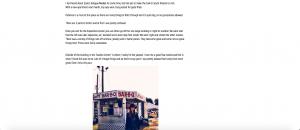After participating in the reflective survey I went back into my blog and made several changes to make it more uniform and easier to navigate. I titled every post more appropriately by naming them according to what they are about. For instance, instead of “Reading Summary One” I revised to “Tapestry Of Space:Reading Summary”. After I changed the titles of all the posts I added more descriptive tags to each post so they can be found easier. I added the author of the original works’ names in the tags so people can find the original work and my work in response to it. Once again I also added tags that pertain to the topic. (Ex:”Sarah Schindler, Architectural Exclusion, Reading Summary, Racism, Discrimination, Classism”.) And finally, I added categories to better organize and unify built environment descriptions or any topic that is covered in more than one post. Categories like “Majestic Diner”, “Cool Atlanta Blog”, and “State Capitol” contain several posts that pertain to that specific place in Atlanta. That way it is easier and quicker for someone looking for information about a specific place in Atlanta to find the correct portion of the blog.
“Sprawl Is Good for You”: Annotated Bib 10
Bruegmann, Robert. “Sprawl Is Good for You.” Politico Magazine. N.p., 8 May 2014. Web. 28 Apr. 2016. <http://www.politico.com/magazine/story/2014/05/sprawl-is-good-for-you-106494_Page2.html#.VyLfnaMrLaY>.
“Sprawl Is Good for You” is an article written by Robert Bruegmann regarding the notion that sprawling cities are problematic and unhealthy. He objects due to the success of cities like Atlanta and Houston. He proves that although residents of the Atlanta and Houston areas are more dependent on automobiles, they also have more access to jobs and opportunities due to the set up of the area. The high density of cities like Chicago result in ultimately a poorer population by the numbers and more health risks in total. People in Atlanta have on average more money and demand more space per person, which explains the high sprawl rate. In that case, sprawl is not necessarily a bad thing at all according to Bruegmann. The author puts together a very factual and well thought out argument by acknowledging concerns and addressing them. I would recommend this source to someone studying this topic.
“Urban Sprawl, Smart Growth, and Deliberative Democracy”: Annotated Bib 9
Resnik, David B. “Urban Sprawl, Smart Growth, and Deliberative Democracy.” American Journal of Public Health. American Public Health Association, n.d. Web. 28 Apr. 2016. <http://www.ncbi.nlm.nih.gov/pmc/articles/PMC2936977/>.
David Resnik cautions in this article that increasing urban sprawl in large amounts in the United States can have adverse affects in the long run on the health of the population. Factors such as pollution from car emissions, water pollution, and deforestation all come in to play when dealing with a large, sprawling city. Why does this problem seem to be getting out of control? The fact that cities are growing faster than they are growing smarter according to Resnik. Before cities are ready to take on large amounts of new residents they should first prepare for them, for what its worth. Cities usually build and make adjustments and adaptations based on what happens instead of what they anticipate happening and that is problematic according to the text. Also Resnik stresses that land owners and developers must be more selfless and less money hungry. Resnik’s article is a well-balanced analysis of what’s happening in America’s cities.
The Impact of Built Environment on Pedestrian Crashes: Annotated Bib 8
“The ATL Urbanist Plan”: Annotated Bib 7
Givens, Dan. “The Anti-Urban Planning Argument for Maintaining Sprawl In Atlanta.” Web blog post. The ATL Urbanist. N.p., 31 May 2015. Web. 28 Apr. 2016. <http://atlurbanist.tumblr.com/post/120390631434/the-anti-urban-planning-argument-for-maintaining>.
This article written on Dan Givens blog is a response to an article written in a newspaper about the growing population of the metropolitan area of Atlanta and what to do about the exponential growth that has been seen recently. The author of the article in question, Wendell Cox, claims that the urban planners are the “bad guys” and are charging high prices to live in the city as they build more and more housing and making for a denser community. Dan Givens insists that Cox’s argument is ridiculous because of the simple real estate and economic rules that are ignored in the conclusion. Givens points out that supply and demand economics would be the obvious culprit for the fluctuation of prices in the city of Atlanta. As more and more people more to the area, the more housing is demanded, and the more people are willing to pay. Especially because it is still cheaper no matter what to live in Atlanta than in most of the northern major cities that the great influx of residents are coming from. Givens puts together a very informative argument and makes good points throughout.
Cool Atlanta Blog:Coffee Shop

Here the Cool Atlanta bloggers profile a cool spot to get coffee under the “coffee shops” umbrella of the main menu. They felt that coffee shops were important enough to have a whole thread dedicated to the best ones of the city. The black and white picture layered by the fancy blue words create a very nice, and elegant look to the page, leading one to draw conclusions about the quality of the restaurant.
Cool Atlanta Blog: Trip To Scott’s Market Review

Here an Atlantan shares her experience visiting a market in Atlanta. She writes a blog post and illustrates it with a photo of her which enhances the visual aspect of the site. The pictures of these people and places together show the true depth of the city better than sentences and paragraphs can.
Cool Atlanta Blog: Personal Profile

This portion of the site profiles a citizen of Atlanta and her style. Clicking on the picture takes you to a gallery of pictures featuring the subject. The site offers a theme of connectivity as Instagram and Facebook links are offered on the side of the main focus. Also links to other areas of the site are accessible from this page.
Cool Atlanta Blog: Graphic Organizer

This graphic organizer shows a list of acts for a music festival in Atlanta. Clicking anywhere on the graphic links you to the webpage of the band you clicked on. This feature makes the site very informative and simple to navigate. The style of the font and the page in general creates a very southern and comfortable feel.
Cool Atlanta Blog: Title Page
 This is the front page of the website that welcomes “Atlanta” to the blog. You can see a portion of the downtown area of the city from the view of the picture. The picture doesn’t show the more typical view of the skyline because they are trying to establish a website for the people who are a part of the community, not just tourists.
This is the front page of the website that welcomes “Atlanta” to the blog. You can see a portion of the downtown area of the city from the view of the picture. The picture doesn’t show the more typical view of the skyline because they are trying to establish a website for the people who are a part of the community, not just tourists.
